MERCEDES-BENZ S-CLASS COUPE 2018 Owner's Manual
Manufacturer: MERCEDES-BENZ, Model Year: 2018, Model line: S-CLASS COUPE, Model: MERCEDES-BENZ S-CLASS COUPE 2018Pages: 502, PDF Size: 6.29 MB
Page 171 of 502
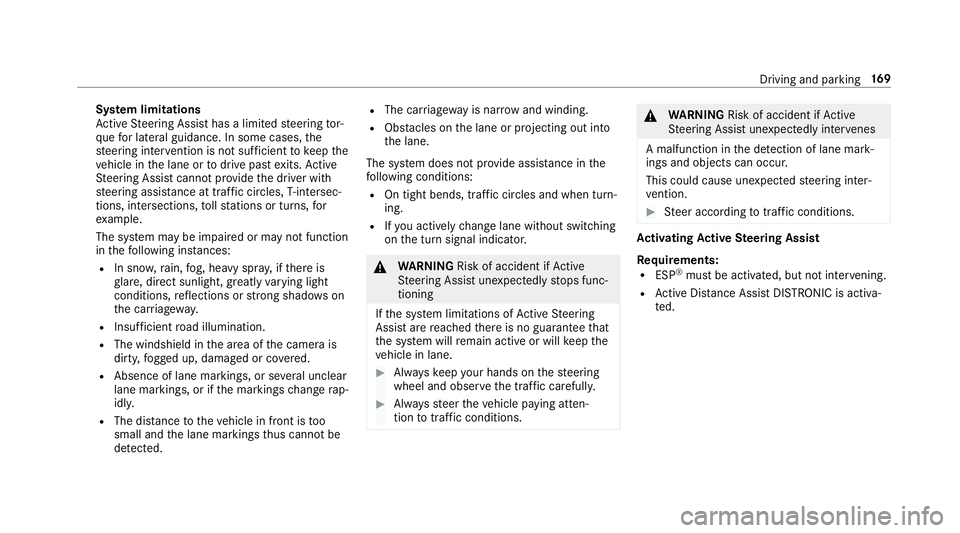
System limitations
Ac tive Steering Assist has a limited steering tor‐
qu efo r lateral guidance. In some cases, the
st eering inter vention is not suff icienttokeep the
ve hicle in the lane or todrive past exits. Active
St eering Assist cann otprov ide the driver with
st eering assis tance at traf fic circles, T-intersec‐
tions, intersections, tollst ations or turns, for
ex ample.
The sy stem may be impaired or may not function
in thefo llowing ins tances:
RIn sno w,rain, fog, heavy spr ay, if there is
gl are, direct sunlight, greatly varying light
conditions, reflections or strong shado wson
th e car riag ewa y.
RInsuf ficient road illumination.
RThe windshield in the area of the camera is
dirty, fogged up, damaged or co vered.
RAbsence of lane markings, or se veral unclear
lane markings, or if the markings change rap‐
idl y.
RThe dis tance totheve hicle in front is too
small and the lane markings thus cannot be
de tected.
RThe car riag ewa yis nar rowand winding.
RObstacles on the lane or projecting out into
th e lane.
The sy stem does not pr ovide assis tance in the
fo llowing conditions:
ROn tight bends, traf fic circles and when turn‐
ing.
RIf yo u act ively change lane without switch ing
on the turn signal indicator.
&
WARNING Risk of accident if Active
St eering Assist unexpectedly stops func‐
tioning
If th e sy stem limitations of Active Steering
Assist are reached there is no guarantee that
th e sy stem will remain active or will keep the
ve hicle in lane.
#Alw ayske ep your hands on thesteering
wheel and obser vethe tra ffic carefull y.
#Alwaysst eer theve hicle paying atten‐
tion totraf fic conditions.
&
WARNING Risk of accident if Active
St eering Assist unexpectedly inter venes
A malfunction in the de tection of lane mark‐
ings and objects can occur.
This could cause unexpected steering inter‐
ve ntion.
#Steer according totraf fic conditions.
Ac tivating Active Steering Assist
Re quirements:
RESP®must be activated, but not inter vening.
RAc tive Dis tance Assist DISTRONIC is acti va‐
te d.
Driving and parking 16
9
Page 172 of 502
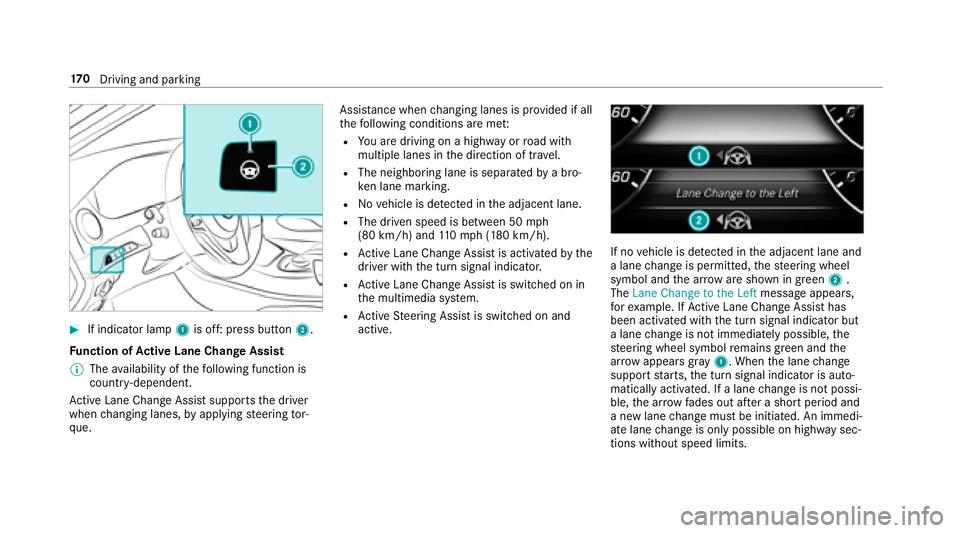
#If indicator lamp1is off: press button 2.
Fu nction of Active Lane Change Assi st
% The availability of thefo llowing function is
countr y-dependent.
Ac tive Lane Change Assi stsupports the driver
when changing lanes, byapplying steering tor‐
qu e. Assis
tance when changing lanes is pr ovided if all
th efo llowing conditions are me t:
RYou are driving on a highwa yor road with
multiple lanes in the direction of tr avel.
RThe neighboring lane is separated bya bro‐
ke n lane mark ing.
RNovehicle is de tected in the adjacent lane.
RThe driven speed is between 50 mph
(80 km/h) and 110mp h(1 80 km/h).
RAc tive Lane Change Assi stis activated bythe
driver with the turn signal indicator.
RAc tive Lane Change Assi stis switched on in
th e multimedia sy stem.
RAc tive Steering Assist is switched on and
active.
If no vehicle is de tected in the adjacent lane and
a lane change is permitte d,thesteering wheel
symbol and the ar row are shown in green 2.
The Lane Change to the Left message appears,
fo rex ample. If Active Lane Change Assi sthas
been activated with the turn signal indicator but
a lane change is not immediately possible, the
st eering wheel symbol remains green and the
ar row appears gray 1. When the lane change
support starts, the turn signal indicator is auto‐
matically activated. If a lane change is not possi‐
ble, the ar row fa des out af ter a short period and
a new lane change must be initiated. An immedi‐
ate lane change is only possible on highw aysec‐
tions without speed limits.
17 0
Driving and pa rking
Page 173 of 502
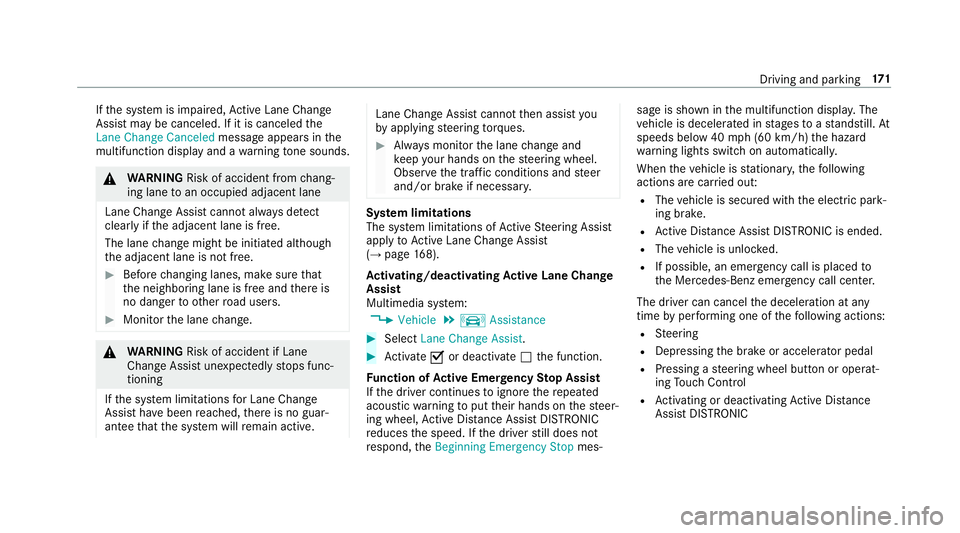
Ifth e sy stem is impaired, Active Lane Change
Assi stmay be canceled. If it is canceled the
Lane Change Canceled message appears inthe
multifunction display and a warning tone sounds.
&
WARNING Risk of accident from chang‐
ing lane toan occupied adjacent lane
Lane Change Assistcannot al ways detect
clear lyifth e adjacent lane is free.
The lane change might be initiated although
th e adjacent lane is not free.
#Before changing lanes, make sure that
th e neighboring lane is free and there is
no danger to otherroad users.
#Monitor the lane change.
&
WARNING Risk of accident if Lane
Change Assist unexpectedlystops func‐
tioning
If th e sy stem limitations for Lane Change
Assist ha vebeen reached, there is no guar‐
antee that the sy stem will remain active.
Lane Change Assist cannot then assist you
by applying steering torques .
#Always monitor the lane change and
ke ep your hands onthesteering wheel.
Obser vethe tra ffic conditions and steer
and/or brake if necessar y.
System limitations
The sy stem limitations of Active Steering Assist
apply toActive Lane Change Assi st
(
→page 168).
Ac tivating/deactivating Active Lane Change
Assi st
Multimedia sy stem:
,Vehicle.k Assistance
#Select Lane Change Assist .
#Activate Oor deacti vate ª the function.
Fu nction of Active Eme rgency Stop Assist
If th e driver continues toigno rethere peated
acoustic warning toput their hands on thesteer‐
ing wheel, Active Dis tance Assist DISTRONIC
re duces the speed. If the driver still does not
re spond, theBeginning Emergency Stop mes‐sage is shown in
the multifunction displa y.The
ve hicle is decelerated in stages toast andstill. At
speeds below 40 mph(6 0 km/h) the hazard
wa rning lights switch on automaticall y.
When theve hicle is stationar y,thefo llowing
actions are car ried out:
RThe vehicle is secured with the electric park‐
ing brake.
RAc tive Dis tance Assist DISTRONIC is ended.
RThevehicle is unloc ked.
RIf possible, an emer gency call is placed to
th e Mercedes-Benz emer gency call center.
The driver can cancel the deceleration at any
time byper form ing one of thefo llowing actions:
RSt eering
RDepressing the brake or accelera tor pedal
RPressing a steering wheel button or operat‐
ing Touch Control
RAc tivating or deacti vating Active Dis tance
Assist DISTRONIC
Driving and pa rking 17
1
Page 174 of 502
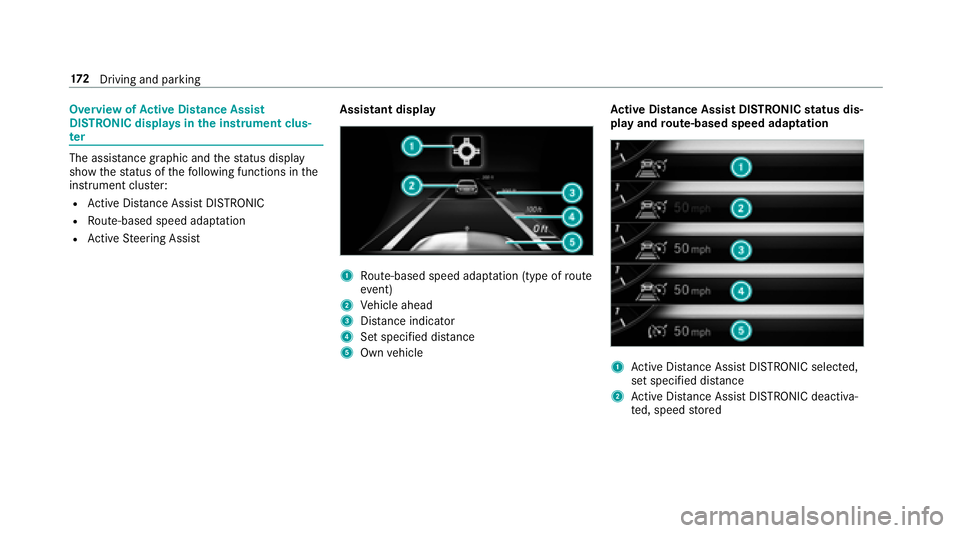
Overview ofActive Di stance Assist
DI STRO NIC displa ysinthe instrument clus‐
te r
The assis tance graphic and thest atus display
show thest atus of thefo llowing functions in the
instrument clus ter:
RAc tive Dis tance Assist DISTRONIC
RRoute-based speed adap tation
RAc tive Steering Assist Assistant display
1Ro
ute-based speed adap tation (type of route
eve nt)
2Vehicle ahead
3Dis tance indica tor
4Set specified di stance
5Own vehicle Ac
tive Di stance Assist DI STRONICstatus dis‐
play and route-based speed adaptation1Ac tive Dis tance Assist DISTRONIC selected,
set speci fied dis tance
2Ac tive Dis tance Assist DISTRONIC deacti va‐
te d, speed stored
17 2
Driving and pa rking
Page 175 of 502
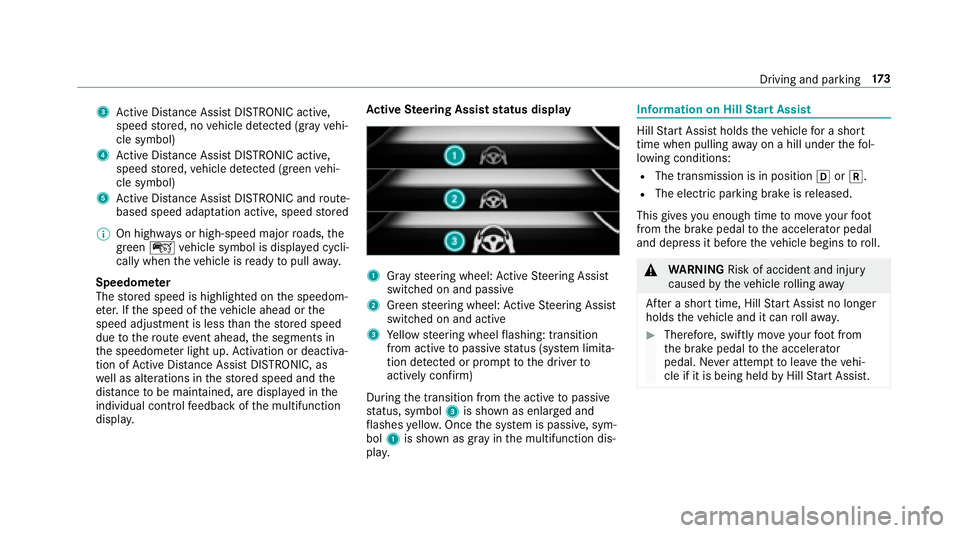
3Active Dis tance Assist DISTRONIC acti ve,
speed stored, no vehicle de tected (gr ayvehi‐
cle symbol)
4Ac tive Dis tance Assist DISTRONIC acti ve,
speed stored, vehicle de tected (green vehi‐
cle symbol)
5Ac tive Dis tance Assist DISTRONIC and route-
based speed adap tation acti ve, speed stored
% On highw ays or high-speed major roads, the
green çvehicle symbol is displa yed cycli‐
cally when theve hicle is ready topull away.
Speedome ter
The stored speed is highlighted on the speedom‐
et er. If the speed of theve hicle ahead or the
speed adjustment is less than thestored speed
due tothero ute event ahead, the segments in
th e speedome ter light up. Activation or deacti va‐
tion of Active Dis tance Assist DISTRONIC, as
we ll as alterations in thestored speed and the
dis tance tobe maintained, are displa yed in the
individual control feedback of the multifunction
displa y. Ac
tive Steering Assist status display
1Gr ay steering wheel: Active Steering Assist
switched on and passive
2Green steering wheel: Active Steering Assist
switched on and active
3Ye llow steering wheel flashing: transition
from active topassive status (sy stem limita‐
tion de tected or prom pttothe driver to
actively con firm )
During the transition from the active topassive
st atus, symbol 3is shown as enlar ged and
fl ashes yello w. Once the sy stem is passive, sym‐
bol 1is shown as gr ayinthe multifunction dis‐
pla y.
Information on Hill Start Assist
Hill Start Assist holds theve hicle for a short
time when pulling away on a hill under thefo l‐
lowing conditions:
RThe transmission is in position hork.
RThe elect ric park ing brake is released.
This gives you enough time tomo veyour foot
from the brake pedal tothe accelera tor pedal
and depress it before theve hicle begins toroll.
&
WARNING Risk of accident and injury
caused bytheve hicle rolling away
Af ter a short time, Hill Start Assist no longe r
holds theve hicle and it can rollaw ay.
#Therefore, swiftly mo veyour foot from
th e brake pedal tothe accelerator
pedal. Ne ver attem pttolea vetheve hi‐
cle if it is being held byHill Start Assist.
Driving and parking 17
3
Page 176 of 502
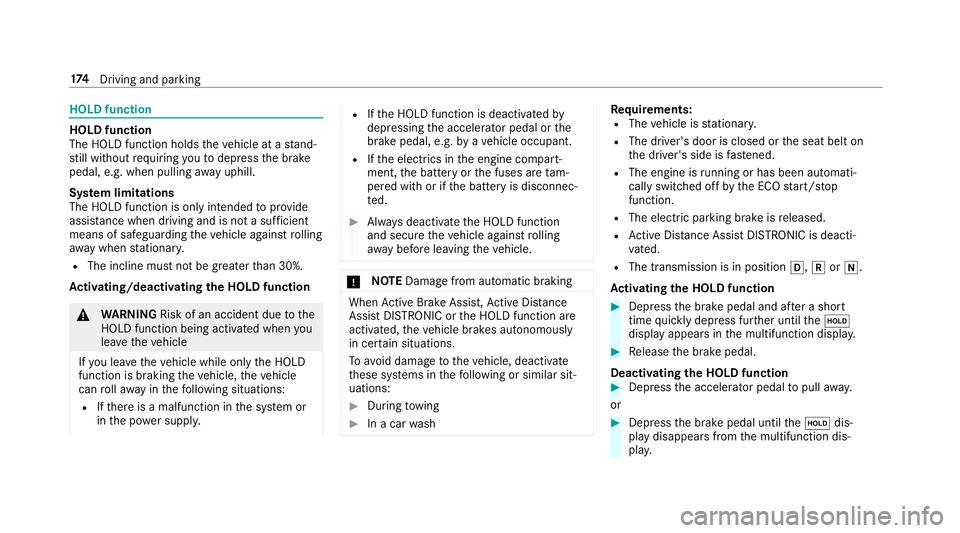
HOLD function
HOLD function
The HOLD function holdstheve hicle at a stand‐
st ill without requ iring youto depress the brake
pedal, e.g. when pulling away uphill.
Sy stem limitations
The HOLD function is only intended toprov ide
assis tance when driving and is not a suff icient
means of safeguarding theve hicle against rolling
aw ay when stationar y.
RThe incline must not be greater than 30%.
Ac tivating/deactivating the HOLD function
&
WARNING Risk of an accident due tothe
HOLD function being activated when you
lea vetheve hicle
If yo u lea vetheve hicle while only the HOLD
function is braking theve hicle, theve hicle
can rollaw ay inthefo llowing situations:
RIf th ere is a malfunction in the sy stem or
in the po wer supply.
RIfth e HOLD function is deactivated by
depressing the accelerator pedal or the
brake pedal, e.g. byave hicle occupant.
RIfth e electrics in the engine compart‐
ment, the battery or the fuses are tam‐
pered with or if the battery is disconnec‐
te d.
#Alw ays deactivate the HOLD function
and secure theve hicle against rolling
aw ay before leaving theve hicle.
* NO
TEDama gefrom au tomatic braking
When Active Brake Assi st,Ac tive Dis tance
Assist DISTRONIC or the HOLD function are
activated, theve hicle brakes autonomously
in cer tain situations.
To avo id damage totheve hicle, deactivate
th ese sy stems in thefo llowing or similar sit‐
uations:
#During towing
#In a car wash
Requirements:RThe vehicle is stationar y.
RThe driver's door is closed or the seat belt on
th e driver's side is fastened.
RThe engine is running or has been au tomati‐
cally switched off bythe ECO start/ stop
function.
RThe electric parking brake is released.
RAc tive Dis tance Assist DISTRONIC is deacti‐
va ted.
RThe transmission is in position h,kori.
Ac tivating the HOLD function
#Dep ress the brake pedal and af ter a short
time quickly depress fur ther until theë
display appears in the multifunction displa y.
#Release the brake pedal.
Deactivating the HOLD function
#Depress the accelerator pedal topull away.
or
#Depress the brake pedal until theë dis‐
play disappears from the multifunction dis‐
pla y.
174
Driving and pa rking
Page 177 of 502
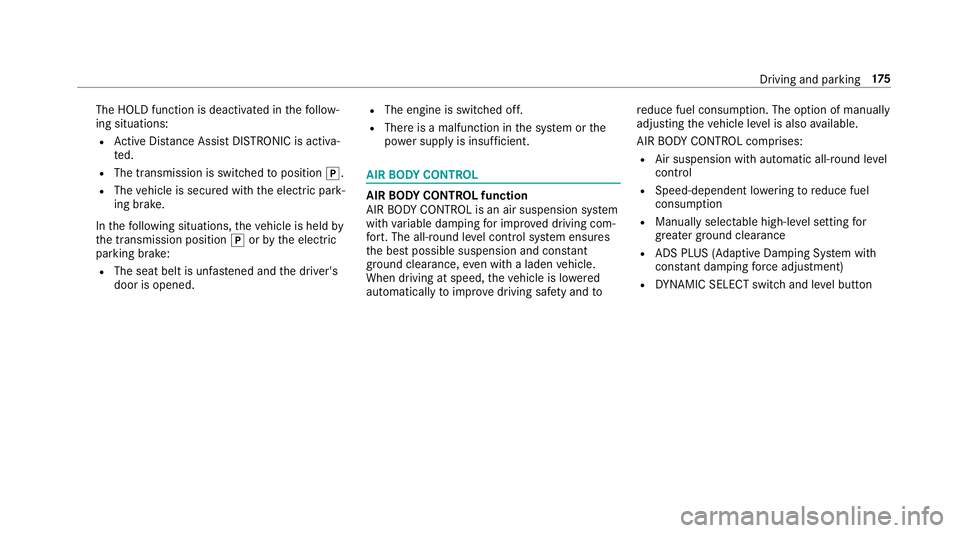
The HOLD function is deactivated inthefo llow‐
ing situations:
RAc tive Dis tance Assist DISTRONIC is acti va‐
te d.
RThe transmission is switched toposition j.
RThevehicle is secured with the electric park‐
ing brake.
In thefo llowing situations, theve hicle is held by
th e transmission position jorby the electric
parking brake:
RThe seat belt is unfas tened and the driver's
door is opened.
RThe engine is switched off.
RThere is a malfunction in the sy stem or the
po we r supply is insuf ficient.
AIR BODY CONT ROL
AIR BODY CONT ROL function
AIR BODY CONTROL is an air suspension sy stem
with variable damping for impr oved driving com‐
fo rt. The all-round le vel control sy stem ensures
th e best possible suspension and const ant
ground clearance, even wi tha laden vehicle.
When driving at speed, theve hicle is lo wered
automatically toimpr ovedriving saf etyand to re
duce fuel consum ption. The option of manually
adjusting theve hicle le vel is also available.
AIR BODY CONTROL comprises:
RAir suspension with automatic all-round le vel
control
RSpeed-dependent lo wering toreduce fuel
consum ption
RManually selecta ble high-level setting for
greater ground clearance
RADS PLUS (Adaptive Damping Sy stem with
const ant damping forc e adjustment)
RDY NA MIC SELECT switch and le vel button
Driving and parking 17
5
Page 178 of 502
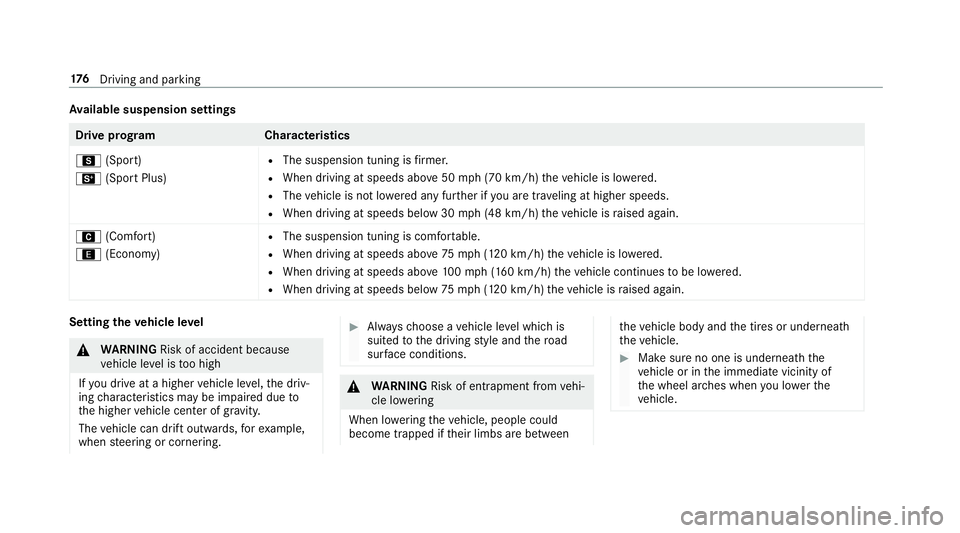
Available suspension settings
Drive prog ramC haracteristics
C (Sport)
B (Sport Plus)
RThe suspension tuning is firm er.
RWhen driving at speeds abo ve50 mph (70 km/h) theve hicle is lo wered.
RThe vehicle is not lo wered any fur ther if you are tra veling at higher speeds.
RWhen driving at speeds below 30 mph(4 8 km/h) theve hicle is raised again.
A (Comfort)
; (Econo my)
RThe suspension tuning is comfor table.
RWhen driving at speeds abo ve75 mph (120 km/h) theve hicle is lo wered.
RWhen driving at speeds abo ve100mp h (160 km/h) theve hicle continues tobe lo wered.
RWhen driving at speeds below 75mph(120 km/h) theve hicle is raised again.
Setting theve hicle le vel
&
WARNING Risk of accident because
ve hicle le vel is too high
If yo udriv e at a higher vehicle le vel,th e driv‐
ing characteristics may be impaired due to
th e higher vehicle center of gr avity.
The vehicle can drift outwards, forex ample,
when steering or cornering.
#Alw aysch oose a vehicle le vel which is
suited tothe driving style and thero ad
sur face conditions.
&
WARNING Risk of entrapment from vehi‐
cle lo wering
When lo wering theve hicle, people could
become trapped if their limbs are between
theve hicle body and the tires or underneath
th eve hicle.
#Make sure no one is underneath the
ve hicle or in the immediate vicinity of
th e wheel ar ches when you lo werth e
ve hicle.
17 6
Driving and pa rking
Page 179 of 502
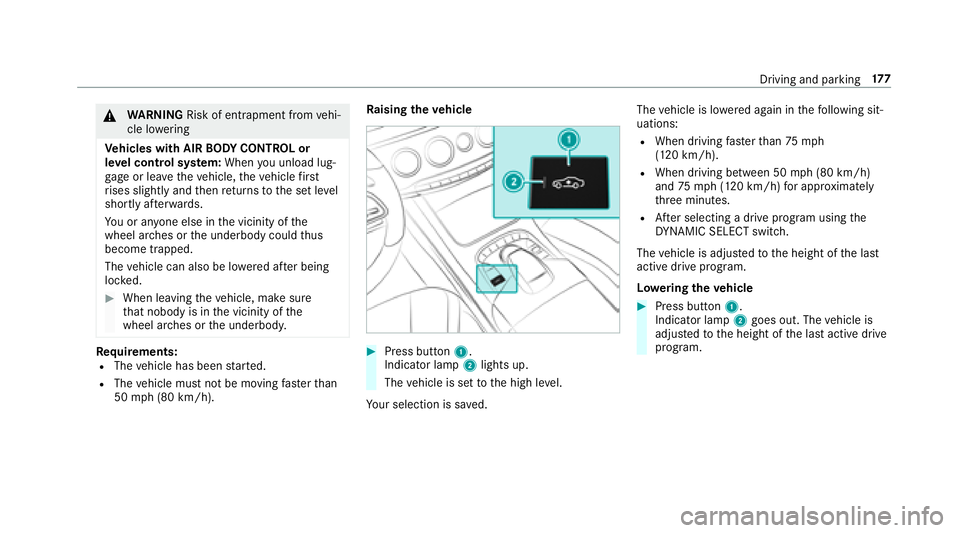
&WARNING Risk of entrapment from vehi‐
cle lo wering
Ve hicles with AIR BODY CONT ROL or
le ve l control sy stem: When you unload lug‐
ga ge or lea vetheve hicle, theve hicle firs t
ri ses slightly and then returns tothe set le vel
shortly af terw ards.
Yo u or an yone else in the vicinity of the
wheel ar ches or the underbody could thus
become trapped.
The vehicle can also be lo wered af ter being
loc ked.
#When leaving theve hicle, make sure
th at nobody is in the vicinity of the
wheel ar ches or the underbody.
Re quirements:RThe vehicle has been star ted.
RThe vehicle must not be moving fasterthan
50 mph(8 0 km/h). Ra
ising theve hicle
#Press button 1.
Indicato r lamp2lights up.
The vehicle is set tothe high le vel.
Yo ur selection issave d. The
vehicle is lo wered again in thefo llowing sit‐
uations:
RWhen driving fasterthan 75 mph
(120 km/h).
RWhen driving between 50 mph (80 km/h)
and 75mph(120 km/h) for app roxima tely
th re e minutes.
RAf ter selecting a drive program using the
DY NA MIC SELECT switch.
The vehicle is adjus tedto the height of the last
active drive prog ram.
Lo weri ngtheve hicle
#Press button 1.
Indicato r lamp2goes out. The vehicle is
adjus tedto the height of the last active drive
program.
Driving and parking 17
7
Page 180 of 502
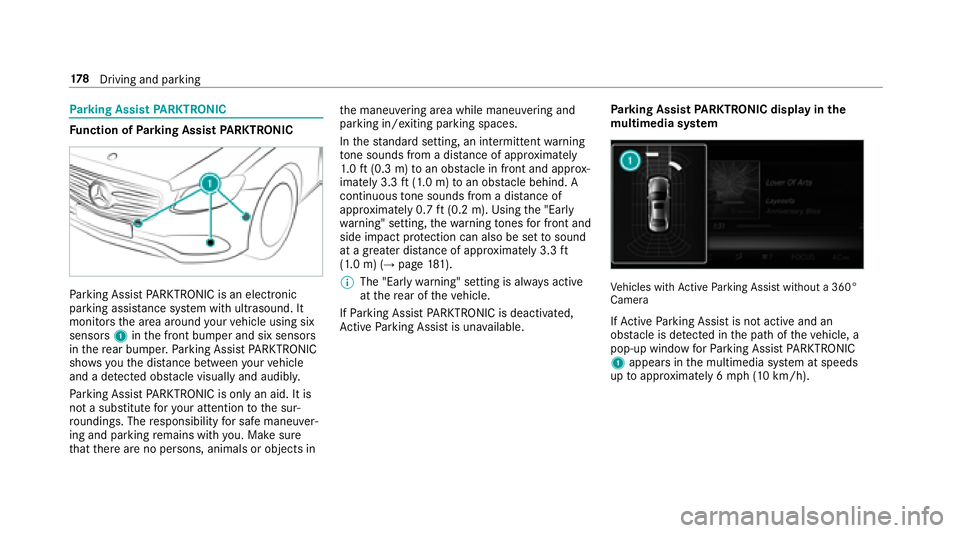
Parking Assist PARKTRONIC
Function of Parking Assist PARKTRONIC
Parking Assist PARKTRONI Cis an electronic
parkin gassi stance sy stem with ultrasound. It
monitors the area around your vehicle using six
sensors 1inthe front bumper and six sensors
in there ar bumper. Parking Assist PARKTRONI C
sho wsyouth e dis tance between your vehicle
and a de tected obs tacle visually and audibly.
Pa rking Assist PARKTRONI Cis on lyan aid. It is
not a substitute foryo ur attention tothe sur‐
ro undings. The responsibility for safe maneu ver‐
ing and parking remains with you. Make sure
th at there are no persons, animals or objects in th
e maneuvering area while maneuvering and
parking in/exiting parking spaces.
In thest andard setting, an intermitte ntwa rning
to ne sounds from a di stance of appr oximately
1. 0 ft (0.3 m) toan obs tacle in front and appr ox‐
imately 3.3 ft(1.0 m) toan obs tacle behind. A
continuous tone sounds from a di stance of
appr oximately 0.7 ft(0.2 m). Using the "Ear ly
wa rning" setting, thewa rning tones for front and
side impact pr otection can also be set tosound
at a greater dis tance of appr oximately 3.3 ft
(1.0 m) (
→page 181).
% The"Ear lywa rning" setting is alw ays active
at there ar of the
ve hicle.
If Pa rkin
g Assist PARKTRONI Cis deacti vated,
Ac tive Parking Assist is una vailable. Pa
rking Assist PARKTRONIC displ ayinthe
mu ltimedia sy stemVe hicles with Active Parking Assist without a 360°
Camera
If Ac tive Parking Assist is not active and an
obs tacle is de tected in the path of theve hicle, a
pop-up window forPa rking Assist PARKTRONI C
1 appear sin the multimedia sy stem at speeds
up toappr oximately 6 mph (10 km/h).
178
Driving and pa rking